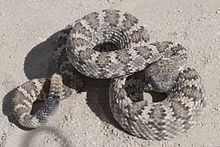Kingdom Animalia Subphylum Vertebrata Suborder Serpentes Higher classification Crotalus mitchellii | Phylum Chordata Order Squamata Family Viperidae Rank Subspecies | |
 | ||
Scientific name Crotalus mitchellii stephensi Similar Rattlesnake, Crotalus mitchellii, Snake, Crotalus mitchellii pyrrhus, Reptile | ||
Crotalus stephensi is a venomous pitviper species found in central and southern Nevada and adjacent California. Common names include panamint rattlesnake, panamint rattler, Owens Valley rattler, and tiger rattlesnake (not to be confused with C. tigris).
Contents
- Crotalus mitchellii stephensi strike mastomys panamint rattlesnake nevada
- Etymology
- Description
- Geographic range
- Feeding
- Reproduction
- References
Crotalus mitchellii stephensi strike mastomys panamint rattlesnake nevada
Etymology
The specific name, stephensi, is in honor of Frank Stephens (1849–1937), curator emeritus of the San Diego Society of Natural History.
Description
Adults of C. stephensi are 58 to 132 cm (23 to 52 in) in total length (including tail), with an average of 60 to 91 cm (24 to 36 in).
According to Klauber (1936), this species is characterized by the absence of the vertical light line on the posterior edge of the prenasal and first supralabial scales. The supraocular scales are pitted, sutured, or with the outer edges broken.
The color pattern consists of a straw, tan, buff, brown, or gray ground color, overlaid with a series of buff, gray, brown, or deep red-brown blotches. Often, gray suffusions occur on the sides of the body and head, and a scattering of black-tipped scales occur on the back, especially at the edges of the blotches.
Geographic range
C. stephensi is found in desert-mountain areas of the eastern slopes of the Sierra Nevada from Mono County, California, east to Nye County, Nevada, south through southwestern Nevada, southeast to Clark County, Nevada, and southwest to central San Bernardino County, California at 900 to 2,400 m (3,000 to 7,900 ft) altitude.
Feeding
The diet of C. stephensi consists of small mammals, lizards, and birds.
Reproduction
C. stephensi is ovoviviparous, and the young are born in July and August. Neonates are about 25 cm in total length.
